Mastering Low Wind Kiteboarding Techniques and Gear
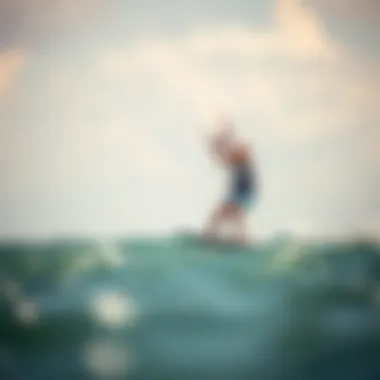
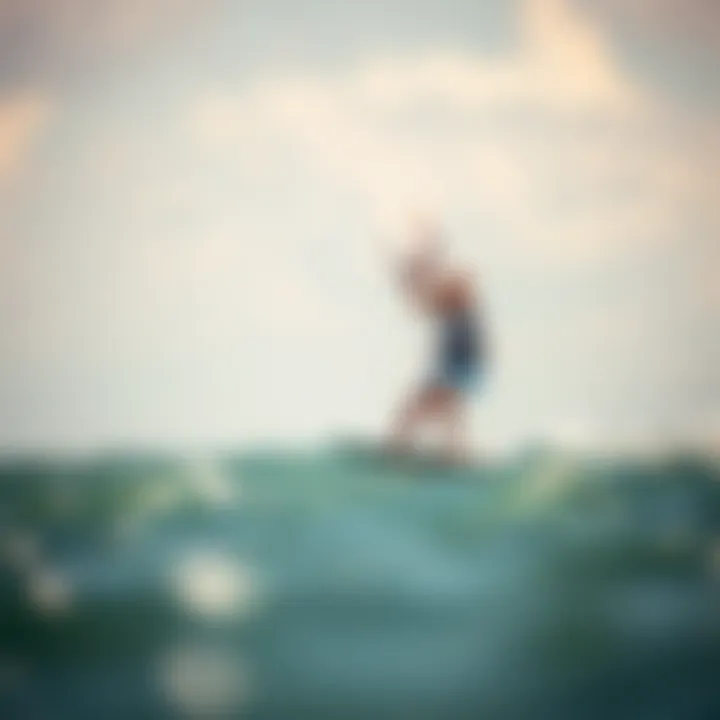
Intro
Low wind kiteboarding presents a unique set of challenges and rewards that separate the true enthusiasts from the fair-weather riders. This sport is not just about catching a breeze; it’s an art that requires precision, patience, and an intimate understanding of wind dynamics. When the wind is barely whispering, the need for specialized techniques and thoughtful equipment becomes paramount. To navigate these lesser winds, one must adapt one’s approach, utilizing equipment designed for low-wind performance, while mastering the maneuvers that keep the experience exhilarating.
In this guide, we will explore the essential gear, maintenance tips, and techniques that will enhance your low wind kiteboarding adventures. Whether you're a novice just dipping your toes in or an advanced rider looking to refine your skills, gaining insight into these areas can help ensure that your kiteboarding experience remains thrilling, no matter how light the breeze.
Equipment Insights
To truly make the most of your time on the water, understanding and utilizing the right gear is vital. Below, we will delve into the latest equipment trends and maintenance practices that cater specifically to low wind conditions.
Latest Gear Reviews
When talking gear, the conversation often starts with kites tailored for low wind. Kites like the Slingshot WindSlicer and the North Kiteboarding Neo are engineered for optimal lift and performance in minimal wind conditions. These kites utilize a larger surface area and specific shaping that enables them to catch any faint breeze effectively.
Here’s what to keep an eye on:
- Size Matters: In low wind, opt for larger kites, typically in the 12m to 15m range, allowing you to harness the available wind better.
- Lightweight Frames: Choosing lighter materials can contribute to performance. Kites that utilize advanced composites and lightweight fabrics deliver better lift.
- Depower Ability: A robust depower system gives you the control necessary for managing your kite in tricky conditions, something crucial when the wind is inconsistent.
Another essential piece to consider is the board. Low wind specific boards, like the Rrd Freestyle Wave or Liquid Force Wheezer, have broader and flatter designs, enabling them to maintain speed even in light winds. Their shape helps in planing effortlessly without the need for excessive speed.
Essential Gear Maintenance
Low wind kiteboarding gear demands care like any other specialized equipment. Here are a few upkeep tips to keep your gear in peak condition:
- Rinse after Use: Always rinse your kite and board with fresh water after each session to remove salt and sand that can cause deterioration.
- Inspect Regularly: Look for wear and tear, particularly on stitching and seams of your kite, and check that no debris has lodged in the valves.
- Deflate Properly: Deflating your kite carefully avoids unnecessary wrinkles and creasing which can affect performance.
Having the right gear paired with routine maintenance not only enhances performance but also extends the life of your equipment, making for a more enjoyable experience on the water.
Technique Exploration
Mastering low wind kiteboarding also comes down to technique. Riding in light winds isn’t just about what kite you ride; it's about how you ride it. Let’s explore the techniques that can elevate your time spent on the water.
Beginner Techniques
For those stepping into low wind kiteboarding for the first time, here are some basic techniques to get you started:
- Kite Positioning: Keep the kite low to the water for maximum pull. This position increases your chances of catching any slight wind.
- Body Position: Lean slightly back to maintain speed. This counteracts the pull of the kite and helps maintain balance.
- Speed Control: Work on getting up to speed via smooth, consistent movements. Quick jerks can lead to loss of control and ultimately result in a less enjoyable ride.
Advanced Maneuvers
As you gain confidence, experimenting with more advanced techniques will enhance your abilities:
- Transition Turns: Learn to make seamless transitions while riding. This skill is beneficial in low wind as it carries momentum and maintains speed.
- Jumping: Low wind jumping can be challenging but rewarding. Properly timing the release of your kite at just the right moment can send you flying, even in light conditions.
"With practice, riding in low winds can be just as thrilling as days with stronger gusts. It's about finding joy in the subtle movements and the dance with nature's breath."
Through focused attention on both gear and technique, you'll not only navigate the gentle winds with grace but also cultivate a deeper appreciation for the sport.
Prolusion to Low Wind Kiteboarding
Low wind kiteboarding brings a distinctive flavor to the kiteboarding world. It opens up entirely new avenues for riders to explore, particularly for those who might not have the luxury of racing gusty winds. Understanding and mastering this discipline is more than just coping with less breeze; it’s about strategy, equipment, and finesse on the water. As kiteboarders, we often chase the strongest winds, yet low winds can offer unmatched tranquility and a different kind of thrill.
When conditions are calm, the essence of kiteboarding shifts. Riders need to possess a nuanced understanding of their kites, allowing them to harness every ounce of power available. The dance between rider and kite becomes intricate—a ballet where subtle changes translate into significant impacts. This article delves into those nuances, focusing on how to thrive in lower wind situations while ensuring safety and enjoyment.
Consider the unique benefits of low wind kiteboarding:
- Accessibility: Less experienced riders can gradually build confidence without the overwhelming force of high winds.
- Peaceful Environment: With less wind noise and fewer waves, it allows for a more serene experience.
- New Skills Development: Navigating low winds forces kiteboarders to refine their technique, enhancing their overall skill set.
The journey into low wind kiteboarding could be compared to savoring a gentle breeze on a warm day; it’s not about where you're going but how you appreciate the ride. As we break down the wind dynamics and the unique appeal of these conditions, we aim to equip every enthusiast with the knowledge they need to make the most of their kiteboarding adventures.
Understanding Wind Dynamics
Wind is the lifeblood of kiteboarding. In low wind conditions, understanding its behavior becomes paramount. Unlike high winds, where kite control is largely about brute force, lower winds require riders to be more strategic and patient.
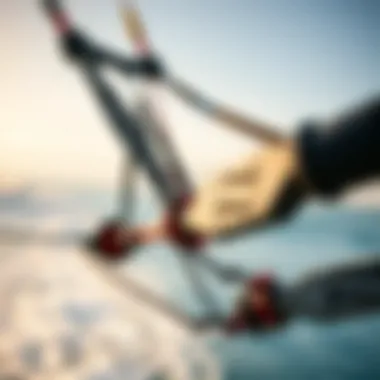
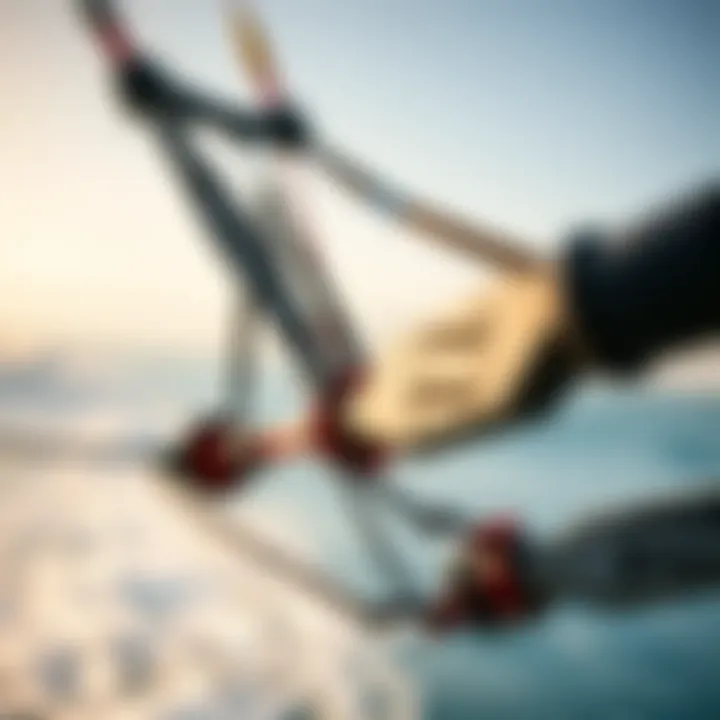
Here are some critical elements of wind dynamics you should grasp:
- Wind Layers: Winds can differ at varying heights. The ground layer might present minimal flow, while higher air currents can provide more leverage.
- Gusts vs. Lulls: Low wind situations often manifest as unpredictable gusts. It’s essential to steer your kite skillfully to mitigate any negative effects from sudden drops.
- Wind Direction: The wind's angle can significantly affect your ride. Position your kite to catch as much power as possible.
The Appeal of Low Wind Conditions
The calm allure of low wind kiteboarding isn't just about enjoying a leisurely glide on the water; it’s about discovery and innovation. Riders can tap into techniques and styles that often get pushed aside in the rush of stronger winds.
Many kiteboarders appreciate low wind for various reasons:
- Less Crowding: With fewer adventurers hitting the water, it often feels like a private escape, perfect for honing your skills in peace.
- Focus on Technique: Lower winds challenge riders to become more in tune with their kites. Riders learn to maximize lift through body positioning and kite handling without relying too heavily on wind power.
- Educational Opportunities: The complexity of riding in low winds opens doors to learning and improvement; it encourages a deeper connection between rider and kite.
"Kiteboarding in low winds is practice in patience and mastery—each ride can become a lesson in finesse."
To conclude this section, low wind kiteboarding offers a fresh perspective that deserves our attention. By diving into the intricacies of wind dynamics and appreciating the unique appeal of low wind conditions, enthusiasts can transform their riding experience and evolve into more skilled practitioners. Armed with this knowledge, kiteboarders can navigate the often underestimated realm of low winds with confidence and ease.
Essential Equipment for Low Wind Kiteboarding
Getting the right equipment is crucial when tackling low wind kiteboarding. The choice of gear can make or break your experience on the water when the breezes are less than ideal. Having equipment tailored to these conditions ensures that you maximize your enjoyment and performance. Understanding the unique characteristics of low wind gear is fundamental for any kiteboarder hoping to excel. This section outlines the essential pieces of equipment—focusing primarily on kites and boards—that play a pivotal role in navigating these calmer conditions.
Choosing the Right Kite
Selecting the appropriate kite is arguably the most significant decision a kiteboarder can make. In low wind conditions, a kite's design deeply influences how well it performs, making this choice foundational.
Features of Low Wind Kites
Low wind kites generally exhibit some specific features that enhance their performance in less airy conditions. One of the standout characteristics is their larger surface area, which helps in catching more air despite the gentler breeze. This larger profile is especially helpful, as it creates increased lift and reduces the overall straining on the rider.
Moreover, these kites often incorporate a more pronounced dihedral shape, which engages the wind more efficiently, thus promoting better stability and control. This feature is particularly beneficial for beginners or those looking to improve their skills in tricky wind situations.
However, not all features are advantageous in every scenario. The wider span can also lead to more drag, which might slow down speed when conditions shift unexpectedly. Hence, understanding these aspects helps inform your choice and enhances your kiteboarding repertoire.
Size and Aspect Ratio Considerations
Delving into the size and aspect ratio of kites, there’s a clear relationship between kite dimensions and performance. Low wind kites often come with a higher aspect ratio, characterized by longer wingspans and narrower profiles. This design allows them to glide more easily and efficiently in lighter winds.
Suitably sized kites can also impact the amount of power generated. A larger kite will generally be more effective in holding its ground in a lull, as it harnesses the available wind more adeptly. However, kites that are too large might lead to overloading, especially for beginner riders. Consequently, keen attention must be paid to your specific weight and skill level when selecting sizes to ensure that don’t fall victim to common pitfalls.
Board Selection and Its Impact
Picking the right board can significantly enhance your low wind experience. Each type of board interacts with the water differently, influencing both speed and maneuverability.
Types of Boards Suitable for Low Wind
When considering boards for low wind situations, those designed specifically for light wind conditions stand out. These boards, often referred to as lightwind or freestyle boards, typically feature a longer and wider design. This structure enables them to glide smoothly over the water surface, even when the wind is scarce.
Additionally, many of these boards come with additional flex and reduced weight. The flex contributes to more effective energy absorption, which can be particularly helpful in bumpy waters or when riding over choppy conditions. They effectively allow the rider to maximize their support from the wind while maintaining control and stability.
But there is a trade-off; these boards may not perform as strongly in stronger winds, often feeling cumbersome and less responsive. It's crucial to find that balance between versatility and specificity.
Board Size and Shape Factors
Finally, understanding the size and shape of the chosen board plays a direct role in overall performance. In low wind kiteboarding, shorter boards can feel more agile as they allow for quick turn initiation, which is vital when trying to maximize lift during sparse gusts.
Conversely, a longer board can glide better but might be harder to maneuver in tight situations or during transitions. A well-rounded approach includes considering your own riding style.
A thoughtful selection of board shape and size can mean the difference between a sluggish day on the water and a thrilling session, even when the wind isn't in full swing.
Techniques for Riding in Low Wind
Kiteboarding in low wind can feel like a dance with the elements, and mastering this art requires skill and finesse. Low wind conditions demand distinct techniques that enhance performance, allowing riders to harness every whisper of breeze to their advantage. The right approach not only amplifies enjoyment on the water but also builds confidence and skills that can translate to better kitesurfing in varied wind conditions. Understanding the intricacies of body position, kite control, and anticipation of wind shifts is vital for anyone aiming to make the most of their low wind outings.
Body Positioning and Weight Distribution
Maintaining Speed and Lift


Maintaining speed and lift is crucial when kiteboarding in light wind. The key here lies in how a rider positions themselves on the board. Keeping bodyweight centered allows for better control of the kite, preventing it from stalling. The critical characteristic is that a balanced position helps maintain consistent speed, which is essential when the wind isn’t doing much lifting.
Imagine gliding just above the water, the board barely kissing the surface every so often. When a rider shifts their weight slightly forward, it can create a subtle lift, allowing the kite to catch what little wind is available. The benefit of this technique is clear: maintaining speed reduces the chances of dragging the board or feeling sluggish in your movements.
Maximizing Power from the Kite
Maximizing power from the kite requires harnessing the available wind effectively. This technique, particularly necessary in lighter conditions, revolves around the size and shape of your kite, but also how you maneuver it through the air. A notable characteristic is the importance of subtle inputs rather than aggressive movements.
Utilizing short strokes on the control lines can boost power without overwhelming the kite. This is beneficial when the wind is light, ensuring the kite stays responsive to small changes. An unexpected downside might be when kite control feels erratic, as too much or too little movement can cause the kite to lose power instead of adding it, making practice overs important.
Effective Kite Control
Small Movements for Better Lift
Small movements can make all the difference when it comes to lift. In low wind, exaggerating your motions usually leads to unwanted turbulence, whereas subtle adjustments allow the kite to capture more airflow without stalling. The standout characteristic here is the heightened sensitivity of the kite to small inputs. By focusing on gentle steering and minimal essentials, riders can feel the kite’s response, unlocking a smoother and more efficient ride.
This technique is particularly useful for newcomers to low wind riding; understanding how to communicate with the kite through gentle commands will enhance board control and airflow management. However, it can take a bit of time to master; patience and practice are key.
Timing and Precision in Steering
Timing and precision in steering can redefine a rider’s experience in low wind conditions. The unique feature of this approach is the synchronization between movement and the changing gusts. By steering the kite at just the right moment, riders can maximize their speed and increase lift when the wind shifts unexpectedly.
The clear advantage is a more controlled and pleasant ride, but the challenge comes from the practice required to develop an intuitive feel for the wind patterns. The rider must learn to anticipate rather than react, which involves a delicate balance of skill and mental agility.
Gusts and Lulls Management
Anticipating Wind Changes
Anticipating wind changes involves keen observation and adaptability. Being aware of the subtle shifts in wind can help a rider prepare their body and kite for incoming gusts or impending lulls. A defining characteristic of this technique is its reliance on intuition and experience. Over time, riders can develop an almost sixth sense for changes in the air around them.
This aspect is essential for low wind kiteboarding, helping riders seamlessly transition through unpredictable conditions without significant disruptions in their ride. However, being caught off guard by sudden changes can be a challenge, requiring practice to refine one's instincts over time.
Adjusting Riding Style
Adjusting riding style is all about being flexible with your technique. This means being willing to alter how you ride based on wind strength and direction. The key characteristic here is the capacity to adapt quickly to changing conditions, shifting one's center of gravity at a moment’s notice.
For example, if the wind dies down, a rider may need to adopt a more aggressive stance to maintain momentum; conversely, when gusts hit, shifting weight can prevent overstressing the kite. The risk lies in making adjustments without a plan, resulting in an awkward ride, so focusing on a solid understanding of individual comfort levels in varying wind is always encouraged.
By integrating these techniques, riders can elevate their low wind kiteboarding experience, turning potential frustrations into exhilarating rides. Understanding and mastering these elements leads not only to better performance but also personal growth as riders explore the nuances of their craft in all wind conditions.
Common Mistakes and How to Avoid Them
When engaging in low wind kiteboarding, knowing the common pitfalls can be a game changer for both novices and seasoned riders alike. Mistakes can not only harm performance but can also lead to damaging equipment or even risking personal safety. Addressing these mistakes head-on can transform a rider's experience, making it smoother and more enjoyable while enabling them to harness the subtleties of low wind conditions.
Over-reliance on Kite Size
One of the chief blunders many kiteboarders make is assuming that the size of their kite is the definitive answer to low wind challenges. While it's tempting to think that a larger kite will always solve the issue of inadequate wind power, this can backfire spectacularly.
In truth, over-relying on kite size can diminish control and performance. A massive kite might catch more wind, sure, but it can also be more cumbersome, especially in light breezes. Riders often find themselves struggling to manage the kite, losing agility and becoming more susceptible to being dragged off course.
To avoid this mistake, consider the following:
- Understand the Wind: Prior to heading out, take note of the current and forecasted wind conditions. A smaller kite may actually perform more effectively if you're well-versed in its control.
- Experience Counts: Don’t shy away from experimenting with different sizes and learn how each one interacts with varying weather conditions. It’s nearly always advisable to favor skill over size.
- Tuning Your Technique: Focus on lifestyle techniques that can help amplify the power generated by the kite, such as proper positioning and weight distribution, instead of just relying on a larger kite.
As a matter of fact, many experts suggest that transitioning to a smaller kite in lower wind situations often leads to improved performance, as it provides better maneuverability and a more exhilarating ride.
Neglecting Technique Fundamentals
Another widespread trap in low wind kiteboarding lies in the neglect of fundamental techniques. When the wind is light, many riders get impatient—launching off without grounding themselves in the basics. This impulsiveness can lead to a disjointed experience.
Fundamental techniques ensure a seamless ride regardless of the wind conditions. In low winds, every little detail becomes paramount; if you miss the basics, you'll find yourself in a dizzying struggle against the elements. Here are a few key aspects to keep in mind:
- Body Positioning: Keep your body low and lean back while balancing on the board to help preserve speed and lift. This positioning helps the board glide more efficiently over the water.
- Kite Steering: Utilize subtle kite movements instead of aggressive pulls. Small, deliberate adjustments can lead to significant improvements in lift, especially when the wind is slice-thin.
- Controlled Acceleration: Initiate your turns slowly and avoid abrupt maneuvers that could stall your kite or drown your rhythm. Gently accelerating while keeping your lines taut can dramatically improve your ride.
In the realm of low wind, every bit counts. Mastering the fundamental techniques can mean the difference between an exhilarating experience and a dreaded struggle.
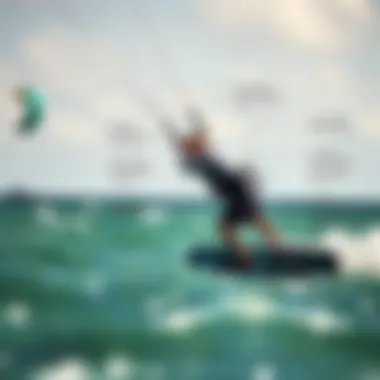
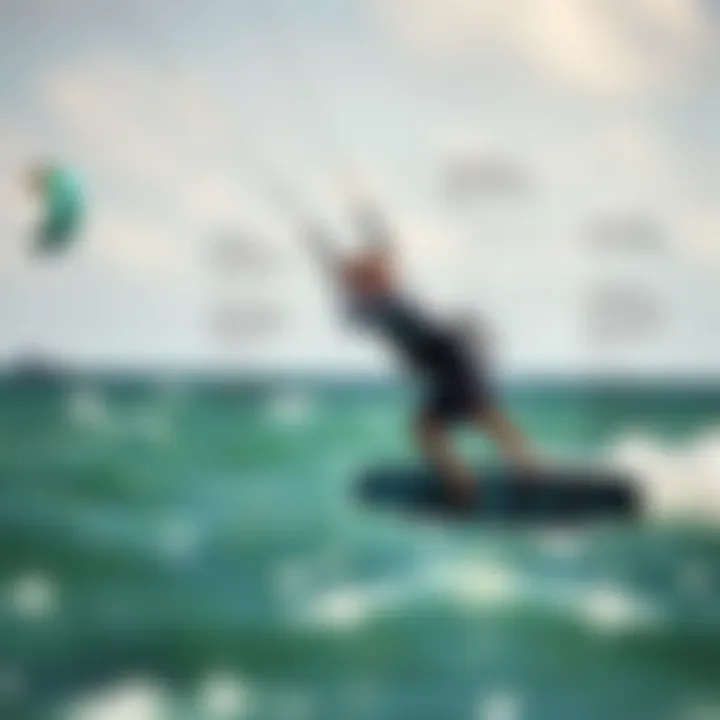
"The true art of kiteboarding doesn’t just lie in the winds that you find. It’s about how you ride them."
To wrap it all up, bypassing these common mistakes opens a new world of potential in low wind kiteboarding. Not only does it make your time on the water safer, but it also enhances the overall experience, leading to mastery over your kite and board no matter how fickle the winds may be.
Safety Considerations in Low Wind
When we mention kiteboarding, especially under low wind conditions, many tend to think it is a breezy affair, both literally and metaphorically. However, the very nature of low wind lends itself to a unique set of considerations that demand serious attention to safety. Whether you are a seasoned pro or a novice, understanding the nuances of low wind safety can safeguard you from potential mishaps while enhancing your overall kiteboarding experience.
Before you hit the water, it’s essential to grasp the risks tied with low wind conditions. Unlike those thrilling windy days when every gust feels like an adrenaline rush, low wind days might not present the immediate thrill but can be deceptively treacherous.
Understanding Risks Associated with Low Winds
Low winds can play tricks on even the best of us. Here are several potential risks to be aware of:
- Loss of Control: With insufficient wind power, maintaining control over the kite can become challenging. If the kite falls into the water, you may find yourself scrambling in an attempt to retrieve it.
- Inconsistent Lift: As wind gusts can be sporadic, your lift might vary greatly. This inconsistency can catch even the most experienced riders off-guard and lead to sudden drops or unwanted tumbles.
- Fatigue: Drifting along or battling the elements due to inadequate wind can quickly lead to fatigue. If you're not aware, you may overstretch your limits, which might lead you to make poor decisions.
- Environmental Risks: Low winds can also result in an increase in obstacles in the water, such as the potential for encountering shallow areas or debris that might not be immediately visible. Keeping an eye out is essential to avoid mishaps.
"Being aware of your surroundings is crucial; a calm sea can hide unpredictable dangers beneath its surface."
Equipment Checks and Maintenance
Before venturing out, perform a thorough equipment check. This isn’t just a precaution; it’s paramount to ensuring your safety during those fluttering winds. Here’s how to go about it:
- Inspect Your Kite: Look for any signs of wear and tear, such as frayed lines or damaged bladders. A sound kite is your primary means of staying afloat.
- Harness Check: Ensure that your harness fits you snugly and has no broken parts. An ill-fitting harness can leave you stranded if you accidentally get separated from your kite.
- Lines and Connectors: Take a careful look at the lines; any knots or tangles or broken connectors can lead to significant issues when you’re out on the water.
- Board Condition: Inspect your board for dings or scratches. This can make all the difference in performance in low wind conditions. If boards are compromised, the ride could turn into quite a difficult experience.
By addressing these safety considerations, you can mitigate risks inherent in low wind kiteboarding. Remember, the peaceful façade of a calm day on the water often hides challenges that can disrupt your ride. Emphasizing safety at every step not only protects you but enriches your time on the water, helping you be a more skilled and responsible kiteboarder. For more tips, consider visiting forums like Reddit Kiteboarding or exploring kiteboarding communities on Facebook.
With a comprehensive understanding of safety in low wind conditions, you can ride with less worry and more confidence.
Community and Resources for Low Wind Kiteboarders
Engaging with a community of like-minded individuals is crucial for anyone interested in low wind kiteboarding. Connecting with fellow kiteboarders exposes you to a wealth of experiences and information that can enhance your learning process and boost your skills. These communities are often vibrant and supportive, providing a sense of belonging where everyone shares the same passion. By tapping into these resources, you can gain not only technical insights but also emotional encouragement.
Online Forums and Groups
Online forums cater to an array of preferences, catering to enthusiasts of every level. Sites like Reddit, especially subreddits related to kiteboarding, provide an open space for discussions ranging from technical advice to sharing photos of recent sessions in low wind. These forums often have sections dedicated to specific topics, enabling users to ask questions and receive tailored feedback.
Social media platforms like Facebook have dedicated groups where members can post about upcoming conditions, share tips about equipment suited for lower winds like the Ocean Rodeo Flite or the Flysurfer Sonic, and even coordinate group outings. Joining these groups allows you to interact with seasoned kiteboarders, gaining access to a collective database of knowledge that can streamline your progress.
Pro Tip: Look for groups with a strong focus on local conditions, as these will be most beneficial for understanding how to leverage your skills in your specific environment.
Events and Competitions
Attending events and competitions can greatly enhance your kiteboarding journey, even if you prefer to ride in low winds. These gatherings aren’t just about competition; they celebrate community and provide an opportunity to learn from others. Events often feature workshops where experienced riders share their techniques, and you can see firsthand how they navigate tricky wind conditions.
Additionally, participating in local competitions, or simply attending as a spectator, exposes you to new gear and innovative techniques that can prove invaluable. You might discover cutting-edge kites designed specifically for lower wind speeds or board designs that enhance performance.
Highlighted Events:
- Kiteboarding Open: Known for its friendly atmosphere and inclusivity, focusing on all skill levels.
- Low Wind Challenge: Specifically targets performance in low wind conditions, offering both competitive and casual events.
Engaging with these events builds camaraderie among participants. You may find a mentor, make lifelong friends, or simply engage in rewarding discussions that shape your understanding of low wind kiteboarding.
Quote: "Going it alone might feel easier, but a community can lift your game and open up new horizons. Together, it’s easier to navigate the breezes that might otherwise hold you back."
The End
As we close the loop on low wind kiteboarding, it’s vital to reflect on the importance of this art. Navigating the thrills of kiteboarding in gentler winds may seem more like a walk in the park than a high-octane adventure, yet it holds equal weight in skill development and enjoyment. Low wind periods can, paradoxically, present some of the most challenging – and rewarding – riding experiences.
Reflecting on the Journey of Low Wind Kiteboarding
The journey through low wind kiteboarding is, in essence, a testament to adaptability and determination. Riders often find themselves refining their skills, even when conditions appear less than favorable. It's not just about the adrenaline rush or the speed; it's the satisfaction of mastering subtle movements and techniques to keep the kite afloat. Each session spins a new story, equipping you with the ability to comfortably maneuver despite uncooperative winds.
The nuance of riding in lower winds begins to turn novices into adept kiteboarders. One notices that what once seemed like simply being pulled along now transforms into a dance with nature. The learning curves may be subtle but packed full of significance: a slight tilt of the kite here, a shift in weight there. Reflecting back upon these small victories sets the stage for future endeavors, enabling riders to embrace challenges faced on the water. There’s something about these low wind days; they forge a deeper respect for the sport and its environment.
Encouragement for Continuous Learning and Exploration
As you fold up that kite after a day on the water, remember that the exploration never truly ends. Low wind kiteboarding is not a one-and-done deal; rather, it blossoms into a lifelong journey filled with lessons. Stay curious and embrace the nuances of your kite and board. Whether it’s experimenting with varied kite sizes or new stances on a board, every moment contributes to a wealth of knowledge.
Engage with online forums such as Reddit Kiteboarding or local kiteboarding meet-ups to exchange tips and tricks with fellow enthusiasts. Perhaps join dedicated groups on Facebook or take part in community events to access a wellspring of experience that can enhance your skill set. Don't shy away from those less-than-ideal wind conditions; instead, see them as an opportunity to hone your technique. The world of kiteboarding is ever-evolving, so remain open to new ideas, innovations in gear, and advances in riding techniques.
In this sport, there’s always a new horizon waiting to be discovered. By continuously seeking improvement and sharing knowledge, you not only elevate your own skills but also uplift the community as a whole. So, grab your kite, keep an open mind, and let the winds guide you.







